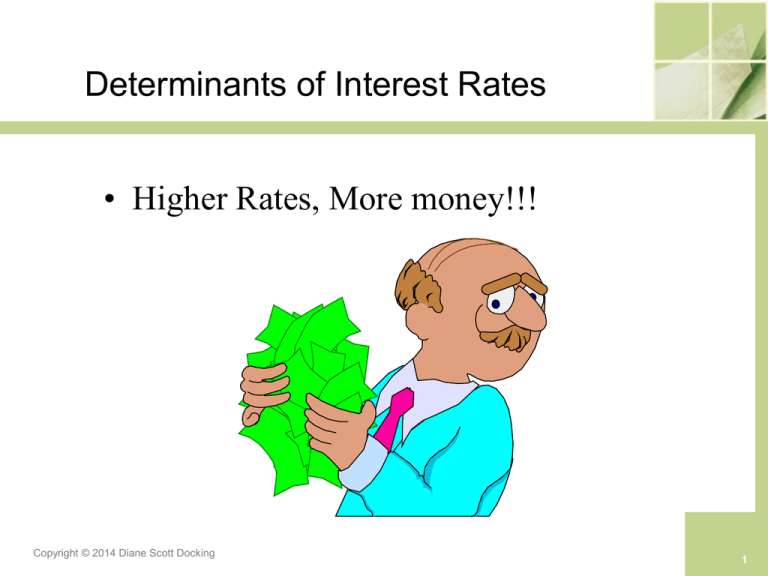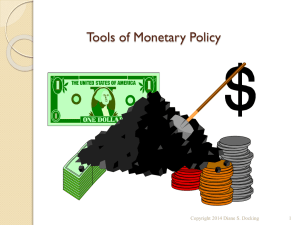Term Structure of Interest Ratesx
advertisement

Determinants of Interest Rates • Higher Rates, More money!!! Copyright © 2014 Diane Scott Docking 1 Learning Objectives • Know what specific factors determine interest rates. • Know what “term structure of interest rates” means. • Understand how forward rates of interest can be derived from the term structure of interest rates. Copyright 2014 by Diane S. Docking 2 What affects interest rates on bonds? Copyright © 2014 Diane Scott Docking 3 The Determinants of Interest Rates • Factors that may influence interest rates: Inflation Current economic activity Expectations of future growth Term to maturity Copyright © 2014 Diane Scott Docking 4 Interest Rates on Different Maturity Bonds Move Together Copyright 2014 by Diane S. Docking http://www.federalreserve.gov/releases/h15/data.htm 5-5 Term to Maturity • Maturity premium - is the additional return required by investors on long-term bonds to compensate investors for the greater price fluctuations as market interest rates change. 6 Copyright © 2014 Diane Scott Docking The Determinants of Interest Rates (cont.) • The Yield Curve and Discount Rates The relationship between the investment term and the interest rate is called the term structure of interest rates We can plot this relationship on a graph called the yield curve Copyright © 2014 Diane Scott Docking 7 Yield Curve Yield % Time to Maturity An upward-sloping yield curve indicates that Treasury Securities with longer maturities offer higher annual yields Copyright © 2014 Diane Scott Docking 8 3 Theories of Term Structure 1. Pure Expectations Theory (aka Unbiased Expectations Theory) 2. Liquidity Premium Theory 3. Market Segmentation Theory Copyright © 2014 Diane Scott Docking 9 Pure Expectations Theory (aka Unbiased Expectations Theory) Key Assumption: Bonds of different maturities are perfect substitutes In words: Rates are a function of investors’ expectations. Copyright © 2014 Diane Scott Docking 10 Derivation – Pure Expectations Theory • Investment strategies for a two-period horizon 1. Buy $1 of one-year bond and when matures buy another one-year bond 2. Buy $1 of two-year bond and hold it • The current spot rate on 1 year Treasury securities is 1R1%, while the current spot rate on 2 year Treasury securities is 1R2%. Year 1 time(beginning of year t) Rmaturity (yrs) Option I: 1R1%, Option II: 1R2%. Year 2 2 f1 % 1R2%. R = observable spot rate f = expected forward rate Copyright © 2014 Diane Scott Docking 11 Derivation – of Geometric Average for Predicting Current L-T Rates under Pure Expectations Theory • Returns should be equal under both options E R I E R II E R I 1 1 R1 1 2 f 1 1 E R II 1 1 R 2 1 1 R 2 1 1 1 R 2 1 1 R 1 1 root 1 1 R 1 E 1 R 2 1 1 f 2 1 1 1 R 2 1 1 1 1/2 2 f 1 1 R 2 1 1 R 1 1 2 f 1 R2 1 1 1 2 2 1 2 2 Cancel common terms, square 1 Copyright © 2014 Diane Scott Docking Solve for current 2-year rate 12 Derivation – of Geometric Average for Predicting Current L-T Rates under Pure Expectations Theory (cont.) In words: Interest rates on long bond (L-T rates) = geometric average of current and expected short-term rates over life of long bond In formula: Predicting Current L-T rates E t R n 1 t R1 1 t 1 f 1 1 t 2 f 1 1 t n 1 f 1 where : R t he observed market rat e, f t he expected forward rat e, t t ime period for which t he rat e is applicable , n maturit y of t he bond. 1 n 1 Arithmetic average for predicting current L-T rates: E t Rn t R1 t 1 f 1 t 2 f 1 ... t n 1 f 1 n Copyright © 2014 Diane Scott Docking 13 Example: Predicting current long-term rates under Pure Expectations Theory The one-year interest rates over the next five years are expected to be 5%, 6%, 7%, 8% and 9%. Based upon the pure expectations theory, what should be today’s interest rate on a 2-year bond?, 3-year bond? 4-year bond? 5-year bond? So Given: 1R1= 5%, 2f1= 6%, 3f1= 7%, 4f1= 8%, 5f1= 9%, Find: 1R2, 1R3, 1R4, 1R5 Copyright © 2014 Diane Scott Docking 14 Example (cont.): Predicting current long-term rates under Pure Expectations Theory Year 1 Option I: 1 R1 % Option II: 1 R2 % Option III: 1 R3 % Option IV: 1 R4 % Option V: 1 R5 % Year 2 2 f1 % Year 3 Year 4 Year 5 3 f1 % 4 f1 % 5 f1 % 3 f1 % 4 f1 % 5 f1 % 4 f1 % 5 f1 % 5 Copyright © 2014 Diane Scott Docking f1 % 15 Solution: Predicting current long-term rates under Pure Expectations Theory Year 1 Option I: 1R1%=5% Option II: 1 R2 % Year 2 2 Year 3 Year 4 Year 5 f1 6 % (1+1R2)2= (1+1R1) (1+2f1) 1/2 -1 R = [(1+ R ) (1+ f )] 1 2 1 1 2 1 1 E 1 R 2 1 . 05 1 . 06 2 1 5 . 499 % Copyright © 2014 Diane Scott Docking 16 Solution: Predicting current long-term rates under Pure Expectations Theory Year 1 Option I: 1R1%=5% Option III: 1 R3 % Year 2 2 f1 6 % Year 3 3 Year 4 Year 5 f1 7 % (1+1R3)3= (1+1R1) (1+2f1) (1+3f1) 1/3 -1 R = [(1+ R ) (1+ f ) (1+ f )] 1 3 1 1 2 1 3 1 1 E 1 R 3 1 . 05 1 . 06 1 . 07 3 1 5 . 997 % Copyright © 2014 Diane Scott Docking 17 Solution: Predicting current long-term rates under Pure Expectations Theory – Geometric Average 1 E 1 R 2 1 . 05 1 . 06 2 1 __________ _ 1 E 1 R 3 1 . 05 1 . 06 1 . 07 3 1 _________ 1 E 1 R 4 1 . 05 1 . 06 1 . 07 1 . 08 4 1 ________ 1 E 1 R 5 1 . 05 1 . 06 1 . 07 1 . 08 1 . 09 5 1 _______ Copyright © 2014 Diane Scott Docking 18 Solution: Predicting current long-term rates under Pure Expectations Theory – Arithmetic Average E 1 R2 E 1 R3 56 ________ 2 567 ________ 3 E 1 R4 5678 E 1 R5 56789 Copyright © 2014 Diane Scott Docking _________ 4 _________ 5 19 Derivation – Pure Expectations Theory: of Geometric Average for Predicting Future S-T Rates • Investment strategies for a two-period horizon 1. Buy $1 of one-year bond and when matures buy another one-year bond 2. Buy $1 of two-year bond and hold it • The current spot rate on 1 year Treasury securities is 1R1%, while the current spot rate on 2 year Treasury securities is 1R2%. Year 1 time(beginning of year t) Rmaturity (yrs) Option I: 1R1%, Option II: 1R2%. Year 2 2 f1 % 1R2%. R = observable spot rate f = expected forward rate Copyright 2014 by Diane S. Docking 20 Derivation – of Geometric Average for Predicting Future S-T Rates under Pure Expectations Theory • Returns should be equal under both options E R I E R II E R I 1 1 R1 1 2 f 1 1 E R II 1 1 R 2 1 1 R 2 1 1 1 R 2 1 1 R 1 1 R 1 1 1 2 1 1 f1 2 f 1 1 1 R 2 1 2 f 1 1 1 1 1 R 2 2 1 1 1 R1 1 1 R2 1 1 2 2 2 Cancel common terms Solve for “Implied” 1-year forward 1-year rate (i.e. 1-yr “Implied” forward rate at beginning of year 2) Copyright © 2014 Diane Scott Docking 21 Derivation – of Geometric Average for Predicting Future S-T Rates under Pure Expectations Theory (cont.) In words: Future S-T interest rates are a function of current S-T and L-T rates In formula: Predicting Future S-T rates E t n 1 1 t R n n f1 1 n 1 1 t R n 1 where : R t he observed market rat e, f t he expected forward rat e, t t ime period for which t he rat e is applicable , n maturit y of t he bond. Copyright © 2014 Diane Scott Docking 22 Example: Forecasting Future Short-term Interest Rates under the Pure Expectations Theory Current rates on bonds are as follows: 1-year bond = 5% 4-year bond = 6.5% 2-year bond = 5.5% 5-year bond = 7% 3-year bond = 6% What is the expected future rate on a 1-year bond at the beginning of year 2 (i.e., 1 year from today)? At the beginning of year 3 (i.e., 2 years from today)? At the beginning of year 4? At the beginning of year 5? So Given: 1R1= 5%, 1R2 = 5.5%, 1R3 = 6%, 1R4 = 6.5%, 1R5 = 7% Find: 2f1, 3f1, 4f1, 5f1 Copyright © 2014 Diane Scott Docking 23 Solution: Forecasting Future Short-term Interest Rates under the Pure Expectations Theory Year 1 Option I: Option II: 1R1=5% 1R2 Year 2 2 Year 3 Year 4 Year 5 f1 % 5.5% (1+1R2)2= (1+1R1) (1+2f1) 2 /(1+ R )] -1 f = [(1+ R ) 2 1 1 2 1 1 E2 1 . 055 2 f1 1 6 . 002 % 1 1 . 05 Copyright © 2014 Diane Scott Docking 24 Solution (cont.): Forecasting Future Short-term Interest Rates under the Pure Expectations Theory Year 1 Option II: 1R2=5.5% Option III: 1R3=6% Year 2 Year 3 3 Year 4 Year 5 f1 % (1+1R3)3= (1+1R2)2 (1+3f1) 3 2 3f1 = [(1+1R3) /(1+1R2) ] -1 E 3 1 . 06 3 f1 1 7 . 0071 % 2 1 . 055 Copyright © 2014 Diane Scott Docking 25 Solution: Forecasting future Short-term Interest Rates under the Pure Expectations Theory E2 E3 1 . 055 2 f1 1 1 . 05 1 . 06 f1 2 1 . 055 Copyright © 2014 Diane Scott Docking 3 1 __________ 1 __________ ___ 26 Solution: Forecasting future Short-term Interest Rates under the Pure Expectations Theory E4 1 . 065 4 f1 1 ________ 3 1 . 06 E5 1 . 07 5 f1 4 1 . 065 Copyright © 2014 Diane Scott Docking 1 _______ 27 3 Theories of Term Structure 1. Pure Expectations Theory (aka Unbiased Expectations Theory) 2. Liquidity Premium Theory Copyright © 2014 Diane Scott Docking 28 Liquidity Premium Theory • Key Assumption: • Implication: Bonds of different maturities are substitutes, but are not perfect substitutes Modifies Pure Expectations Theory with features of Market Segmentation Theory • Investors prefer short-term rather than long-term bonds. This implies that investors must be paid positive liquidity premium, ℓnt, to hold long term bonds. Copyright © 2014 Diane Scott Docking 29 Derivation – Liquidity Premium Theory • Investment strategies for a two-period horizon 1. Buy $1 of one-year bond and when matures buy another one-year bond 2. Buy $1 of two-year bond and hold it Long-term interest rates are geometric averages of current and expected future short-term interest rates plus liquidity risk premiums that increase with maturity Year 1 Option I: Option II: 1R1%, 1R2%. Year 2 2 f1 % 2 % 1R2%. Copyright © 2014 Diane Scott Docking 30 Derivation – of Geometric Average for Predicting Current L-T Rates under Liquidity Premium Theory • Returns should be equal under both options E R I E R II E R I 1 1 R1 1 2 f 1 2 1 E R II 1 1 R 2 1 1 R 2 1 1 1 R 2 1 1 R 1 1 1 1 R 1 1 E 1 R 2 1 1 1 R 1 2 f 1 2 1 1 1 R 2 1 2 2 f 1 2 2 1/2 2 1 1 R 2 1 1 R 1 1 2 f 1 2 2 1 2 Cancel common terms, square root 1 Copyright © 2014 Diane Scott Docking Solve for current 2-year rate 31 Derivation – of Geometric Average for Predicting Current L-T Rates under Liquidity Premium Theory (cont.) • Long-term interest rates are geometric averages of current and expected future short-term interest rates plus liquidity risk premiums that increase with maturity Geometric average for predicting current L-T rates: E t R n 1 t R1 1 t 1 f 1 t 1 ... 1 t n 1 f 1 t n 1 1 n 1 ℓt = liquidity premium for period t ℓ2 < ℓ3 < …< ℓn Copyright © 2014 Diane Scott Docking 32 Example: Predicting current long-term rates under Liquidity Premium Theory The one-year interest rates over the next four years are expected to be 5%, 6%, 7%, 8% and 9%. Investors' preferences for holding short-term bonds, so liquidity premiums for one- to five-year bonds are 0%, 0.25%, 0.5%, 0.75%, and 1%. Based upon the liquidity premium theory, what should be today’s interest rate on a 2-year bond?, 3-year bond? 4-year bond?, 5-year bond? So Given: 1R1= 5%, 2f1= 6%, 3f1= 7%, 4f1= 8%, 5f1= 9%, ℓ1= 0%, ℓ2= 0.25%, ℓ3= 0.5%, ℓ4= 0.75%, ℓ5= 1%, Find: 1R2, 1R3, 1R4, 1R5 Copyright © 2014 Diane Scott Docking 33 Example (cont.): Predicting current long-term rates under Liquidity Premium Theory Year 1 Option I: 1 R1 % Option II: 1 R2 % Option III: 1 R3 % Option IV: 1 R4 % Option V: 1 R5 % Year 2 2 f1 % 2 % Year 3 Year 4 Year 5 3 f1 % 3 % 4 f1 % 4 % 5 f1 % 5 % 3 f1 % 3 % 4 f1 % 4 % 5 f1 % 5 % 4 f1 % 4 % 5 f1 % 5 % 5 f1 % 5 % Copyright © 2014 Diane Scott Docking 34 Solution: Predicting current long-term rates under Liquidity Premium Theory Year 1 Option I: 1 R1 % Option II: 1 R2 % Year 2 2 Year 3 Year 4 Year 5 f1 % 2 % (1+1R2)2= (1+1R1) (1+2f1+ℓ2) 1/2 -1 R = [(1+ R ) (1+ f +ℓ )] 1 2 1 1 2 1 2 1 R 2 1 1 R1 1 2 f 1 2 1 1 . 05 1 . 06 . 0025 1 . 05 1 . 0625 1 2 2 1 1 2 1 1 5 . 6232 % Copyright © 2014 Diane Scott Docking 35 Solution: Predicting current long-term rates under Liquidity Premium Theory R 2 1 1 R1 1 2 f 1 2 1 1 2 1 . 05 1 . 06 . 0025 1 . 05 1 . 0625 1 1 2 1 1 2 1 1 _________ R 3 1 1 R1 1 2 f 1 2 1 3 f 1 3 1 . 05 1 . 0625 1 . 07 . 005 1 . 05 1 . 0625 1 . 075 Copyright © 2014 Diane Scott Docking 1 3 1 1 3 3 1 1 1 _________ 36 Solution: Predicting current long-term rates under Liquidity Premium Theory 1 1 R 4 1 1 R1 1 2 f 1 2 1 3 f 1 3 1 4 f 1 4 1 . 05 1 . 0625 1 . 075 1 . 08 . 0075 1 . 05 1 . 0625 1 . 075 1 . 0875 1 4 1 4 1 4 1 1 1 ________ R 5 1 1 R1 1 2 f 1 2 1 3 f 1 3 1 4 f 1 4 1 5 f 1 5 1 . 05 1 . 0625 1 . 075 1 . 0875 1 . 09 . 01 1 . 05 1 . 0625 1 . 075 1 . 0875 1 . 10 Copyright © 2014 Diane Scott Docking 1 5 1 5 1 5 1 1 1 ________ 37 Relationship Between the Liquidity Premium and Pure Expectations Theory Copyright © 2014 Diane Scott Docking 38 Relationship Between the Liquidity Premium and Pure Expectations Theory Our Example Copyright © 2014 Diane Scott Docking 39 Derivation – Liquidity Premium Theory Predicting Future S-T Rates • Investment strategies for a two-period horizon 1. Buy $1 of one-year bond and when matures buy another one-year bond 2. Buy $1 of two-year bond and hold it Assumption: Long-term interest rates already include liquidity premium Year 1 Option I: Option II: 1R1% - ℓ1% 1R2% - ℓ2% Year 2 2 1 R2 % f1 % - ℓ2% Copyright © 2014 Diane Scott Docking 40 Derivation – of Geometric Average for Predicting Future S-T Rates under Liquidity Premium Theory • • Returns should be equal under both options Assume current long-term rates already include the liquidity premium. E R I E R II E R I 1 1 R1 1 1 2 f 1 1 E R II 1 1 R 2 2 1 1 R 2 2 1 1 1 R 2 2 1 1 R 1 1 R 1 1 1 1 1 2 f 1 1 2 f 1 1 1 1 R 2 2 1 1 1 R 1 1 1 R 2 2 1 1 R1 1 1 2 2 f1 1 1 2 1 2 2 2 2 Cancel common terms, square root Solve for “Implied” 1-year forward 1-year rate (i.e. 1-yr “Implied” forward rate at beginning of year 2) Copyright © 2014 Diane Scott Docking 41 Formula for Predicting Future S-T Rates under Liquidity Premium Theory Liquidity Premium Theory: tRn- ℓnt = same as pure expectations theory; replace tRn by tRn- ℓnt in above equation to get adjusted forward-rate forecast E t n 1 1 t R n nt n f1 1 n 1 1 t R n 1 nt 1 where : R t he observed market rat e, f t he expected forward rat e, t t ime period for which t he rat e is applicable , n maturit y of t he bond. Copyright © 2014 Diane Scott Docking 42 Example: Forecasting future Short-term Interest Rates under the Liquidity Premium Theory Current rates on bonds are as follows: 1-year bond = 5% 4-year bond = 6.5% 2-year bond = 5.5% 5-year bond = 7% 3-year bond = 6% Investors' preferences for holding short-term bonds, so liquidity premiums for one- to five-year bonds are 0%, 0.25%, 0.5%, 0.75%, and 1% What is the expected future rate on a 1-year bond at the beginning of year 2 (i.e., 1 year from today)? At the beginning of year 3 (i.e., 2 years from today)? At the beginning of year 4? At the beginning of year 5? So Given: 1R1= 5%, 1R2 = 5.5%, 1R3 = 6%, 1R4= 6.5%, 1R5 = 7% ℓ1= 0%, ℓ2= 0.25%, ℓ3= 0.5%, ℓ4= 0.75%, ℓ5= 1%, Find: 2f1, 3f1, 4f1, 5f1 Copyright © 2014 Diane Scott Docking 43 Solution: Forecasting future Short-term Interest Rates under the Liquidity Premium Theory Year 1 Year 2 Option I: 1R1- ℓ1=5%-0% Option II: 1R2- ℓ2=5.5%-0.25% 2 Year 3 Year 4 Year 5 f1 % (1+1R2-ℓ2)2= (1+1R1-ℓ1) (1+2f1) 2 2f1 = [(1+1R2-ℓ2) /(1+1R1-ℓ1)] -1 E2 1 0 . 055 0 . 0025 f1 1 1 0 . 05 0 Copyright © 2014 Diane Scott Docking 2 1 1 . 0525 2 1 5 . 5006 % 1 1 . 05 44 Solution: Forecasting future Short-term Interest Rates under the Liquidity Premium Theory Year 1 Year 2 Option II: 1R2- ℓ2=5.5%-0.25% Option III: 1R3- ℓ3=6%-0.5% (1+1R3-ℓ3)3= (1+1R2-ℓ2)2 (1+3f1) 3 2 3f1 = [(1+1R3-ℓ3) /(1+1R2-ℓ2) ] -1 Year 3 3 E3 Year 4 Year 5 f1 % 1 0 . 06 0 . 005 3 f1 1 2 1 0 . 055 0 . 0025 Copyright © 2014 Diane Scott Docking 1 . 055 3 1 6 . 0018 % 2 1 . 0525 45 Solution: Forecasting future Short-term Interest Rates under the Liquidity Premium Theory E2 E3 1 0 . 055 0 . 0025 f1 1 1 . 05 2 1 ________ 1 0 . 06 0 . 005 3 f1 2 1 0 . 055 0 . 0025 Copyright © 2014 Diane Scott Docking 1 ________ 46 Solution: Forecasting future Short-term Interest Rates under the Liquidity Premium Theory E4 1 0 . 065 0 . 0075 4 f1 3 1 0 . 06 0 . 005 E 5 1 _______ 1 0 . 07 0 . 01 5 f1 4 1 0 . 065 0 . 0075 Copyright © 2014 Diane Scott Docking 1 _______ 47 3 Theories of Term Structure 1. Pure Expectations Theory (aka Unbiased Expectations Theory) 2. Liquidity Premium Theory 3. Market Segmentation Theory Copyright © 2014 Diane Scott Docking 48 Market Segmentation Theory • Key Assumption: Bonds of different maturities are not substitutes at all • Implication: Markets are completely segmented; interest rate at each maturity are determined separately • • Short- and long-term markets are independent of one another and yields are determined by supply and demand in each maturity market sector. Assumes borrowers and lenders prefer certain maturities and cannot be induced to substitute between maturities by small yield changes Copyright © 2014 Diane Scott Docking 49 Yield Curves http://fixedincome.fidelity.com/fi/FIHistoricalYield?refpr=obrfi14 http://stockcharts.com/charts/YieldCurve.html Copyright © 2014 Diane Scott Docking 50





